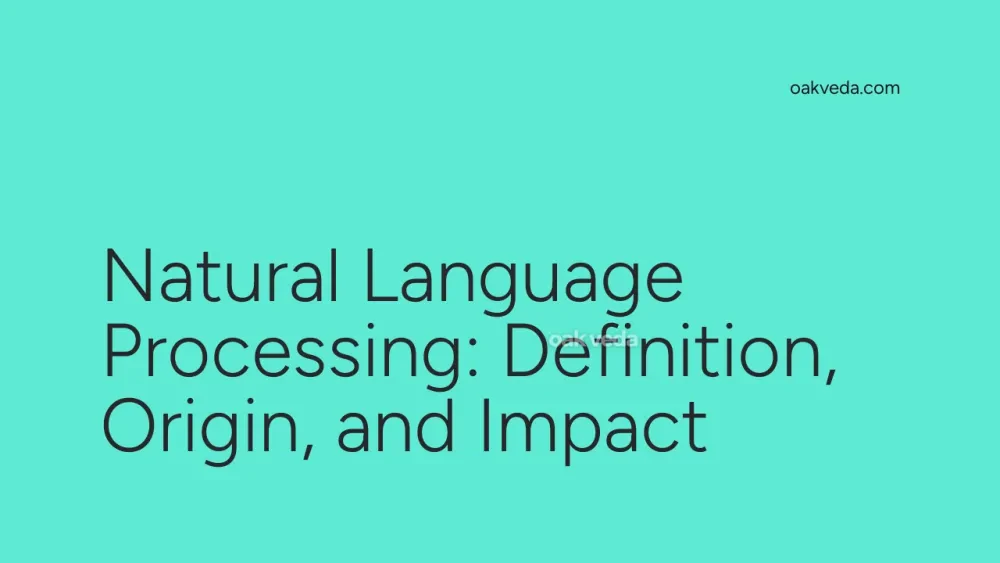
What is Natural Language Processing?
Natural Language Processing (NLP) is a branch of artificial intelligence that focuses on the interaction between computers and human language. It involves developing algorithms and models that enable machines to understand, interpret, and generate human language in a meaningful way. NLP bridges the gap between human communication and computer understanding, making it possible for machines to process and analyze vast amounts of textual data.
Origin and Development of Natural Language Processing
The concept of NLP dates back to the 1950s, with early experiments in machine translation. However, significant progress in the field began in the 1980s with the introduction of machine learning techniques. The development of NLP has been marked by several key milestones:
- 1950s: Early attempts at machine translation
- 1960s: ELIZA, one of the first chatbots, is created
- 1980s: Introduction of statistical NLP methods
- 2000s: Rise of machine learning and data-driven approaches
- 2010s: Deep learning revolution in NLP
- 2020s: Large language models like GPT-3 and BERT
How Natural Language Processing Works
NLP systems typically involve several stages of processing:
- Tokenization: Breaking text into individual words or phrases
- Part-of-speech tagging: Identifying the grammatical role of each word
- Named entity recognition: Identifying and classifying named entities (e.g., people, organizations, locations)
- Syntactic parsing: Analyzing the grammatical structure of sentences
- Semantic analysis: Understanding the meaning and context of the text
- Pragmatic analysis: Interpreting the overall message and intent
These processes rely on various techniques, including statistical modeling, machine learning, and deep learning algorithms.
Types of Natural Language Processing Tasks
NLP encompasses a wide range of tasks, including:
- Text classification: Categorizing text into predefined groups
- Sentiment analysis: Determining the emotional tone of text
- Machine translation: Translating text from one language to another
- Text summarization: Generating concise summaries of longer texts
- Question answering: Providing accurate answers to natural language questions
- Speech recognition: Converting spoken language into text
- Text generation: Creating human-like text based on input or prompts
Popular Examples of Natural Language Processing in Social Media
- Chatbots and virtual assistants: Facebook Messenger bots, Twitter's customer service bots
- Content moderation: Automatic detection of hate speech, spam, and inappropriate content
- Trend analysis: Identifying emerging topics and hashtags on platforms like Twitter and Instagram
- Personalized content recommendations: Suggesting relevant posts, articles, or products based on user interests
- Automated content tagging: Generating hashtags or categories for user-generated content
Impact of Natural Language Processing on Social Media Culture
NLP has significantly transformed social media culture in several ways:
- Enhanced user experience: Improved search functionality, personalized content feeds, and more relevant recommendations
- Real-time insights: Enabling brands to monitor and respond to customer sentiment and emerging trends quickly
- Automated content creation: Assisting in generating social media posts, captions, and even entire articles
- Language accessibility: Facilitating communication across language barriers through automatic translation
- Improved content moderation: Helping platforms combat misinformation, hate speech, and spam more effectively
Controversies and Debates Surrounding Natural Language Processing
While NLP has brought numerous benefits, it has also raised concerns:
- Privacy issues: The use of NLP for analyzing personal communications and data
- Bias in algorithms: Potential for reinforcing societal biases in language models
- Job displacement: Concerns about automation replacing human roles in content creation and moderation
- Misinformation: The potential misuse of advanced text generation models to create fake news or misleading content
How Brands and Influencers Use Natural Language Processing
Brands and influencers leverage NLP in various ways:
- Sentiment analysis: Monitoring brand perception and customer feedback
- Influencer identification: Finding relevant influencers based on content analysis
- Content optimization: Using NLP insights to create more engaging and shareable content
- Audience segmentation: Analyzing user-generated content to better understand target audiences
- Automated customer service: Implementing chatbots for quick response to common queries
Future Trends Related to Natural Language Processing
The future of NLP in social media looks promising, with several emerging trends:
- Multimodal NLP: Combining text analysis with image and video understanding
- Emotion AI: More nuanced detection of emotions and intent in social media posts
- Multilingual NLP: Improved cross-language understanding and translation
- Explainable AI: Developing NLP models that can explain their decision-making processes
- Personalized content generation: Creating highly tailored content for individual users
FAQs about Natural Language Processing
-
How accurate is NLP in sentiment analysis? Modern NLP models can achieve accuracy rates of 70-80% in sentiment analysis, depending on the complexity of the text and the specific use case.
-
Can NLP understand sarcasm and humor? While NLP has made progress in detecting sarcasm and humor, it remains a challenging task due to the nuanced nature of these forms of expression.
-
How does NLP handle different languages and dialects? NLP models can be trained on multiple languages, and recent advancements have improved performance on low-resource languages and dialects.
-
Is NLP used in voice-based social media features? Yes, NLP is crucial for voice-to-text transcription and understanding voice commands in social media apps and features.
-
How can small businesses leverage NLP for social media marketing? Small businesses can use NLP-powered tools for social listening, content analysis, and automated customer interactions to enhance their social media presence.
Natural Language Processing continues to evolve rapidly, shaping the future of social media interactions and digital communication. As the technology advances, we can expect even more sophisticated applications that will further transform how we create, consume, and interact with content on social platforms.
You may be interested in:
- Koji: Definition, Origin, and Impact on Social Media
- IMO: Definition, Origin, and Impact on Social Media
- Community Manager: Definition, Origin, and Impact
- Social Listening: Definition, Origin, and Impact
- Altered My Brain Chemistry: Definition, Origin, and Impact
- Loop: Definition, Origin, and Impact on Social Media

